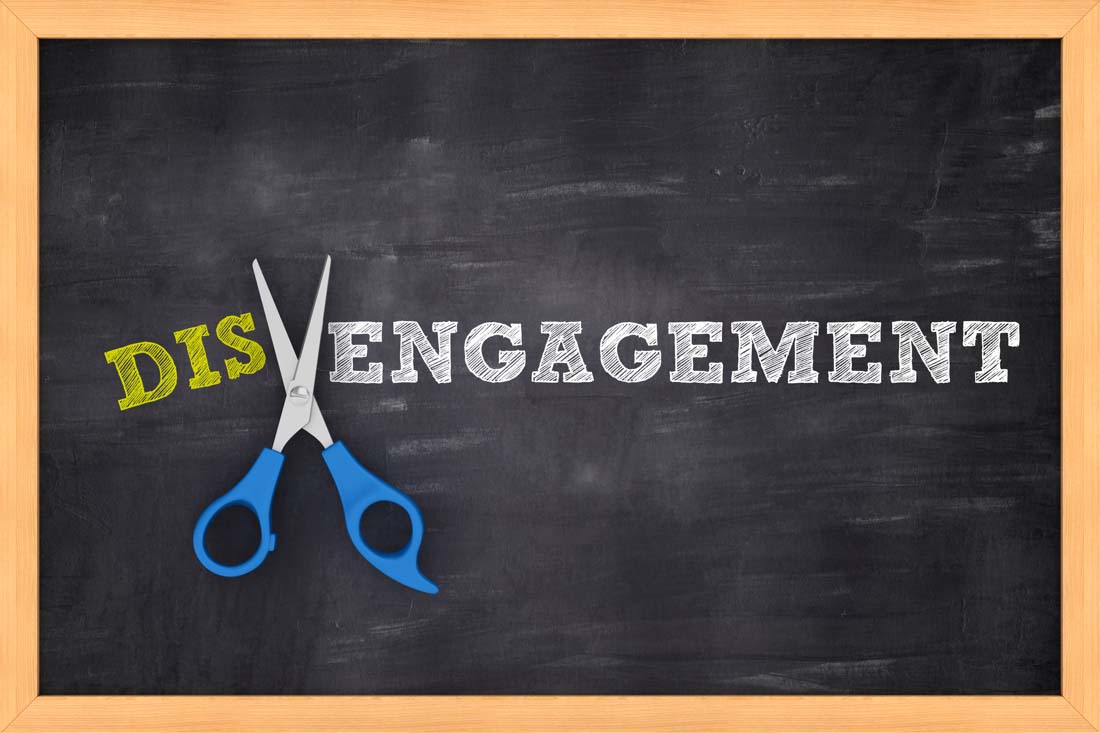How many of your employees are disengaged and dissatisfied at work? According to the latest studies, it’s probably more than you think.
As a business leader, it’s your job to understand the stages of disengagement and how to reverse them. Yet for many managers, the causes of low engagement remain a mystery.
To help, let’s examine the five stages of employee disengagement, along with strategies to counter and prevent it.
What is employee disengagement?
Employee disengagement is a state where people lack motivation, commitment and enthusiasm at work. It’s the opposite of employee engagement. Instead of feeling invested in their jobs, coworkers and company, disengaged employees experience high levels of discontent, boredom and resentment. By the final stage of disengagement, an employee is completely detached from the company’s mission, vision and goals. They do the bare minimum to earn a paycheck and feel stuck in their careers.
Low engagement surfaces in various ways, but managers often remain unaware of the problem until its final stages. By then, companies face a downward spiral of decreased productivity, low performance, high attrition and customer dissatisfaction.
The impact of disengagement on the workplace
More than half of employees say they’re disengaged at work. But without a way to track early warning signs, disengagement is difficult to detect. As a result, it extends beyond individual performance to permeate the entire workplace.
One study found disengagement costs the world $8.8 trillion in lost productivity. Another calculated the cost of employee disengagement and attrition for a median-size S&P 500 company at $228 to $355 million a year. And according to Gallup, actively disengaged employees are more likely to steal from their companies, negatively influence coworkers, miss workdays and drive customers away.
In other words: disengagement is dangerous. It affects team dynamics, collaboration and, ultimately, your bottom line. These ripple effects create a downward spiral if left unaddressed, creating a toxic work environment that hinders innovation and growth.
What causes employee disengagement?
The sooner you recognize the signs of employee disengagement, the faster you can intervene. While some causes are out of your control — such as issues in employees’ personal lives — most stem from organizational issues. Common causes include:
- Inadequate communication: A lack of open communication from leadership on company goals, expectations and changes leads to misunderstandings and confusion.
- Poor role alignment: When people don’t understand how their roles align to company goals, they’re less likely to be engaged.
- Limited career growth opportunities: Being stuck in the same role with the same responsibilities year after year leaves employees feeling stagnant and unchallenged.
- A toxic work environment: While company cultures defined by trust and transparency lead to high levels of employee engagement, the opposite occurs with a lack of empathy and ineffective leadership.
- Lack of recognition: Employees who are never shown appreciation may feel their work doesn’t matter.
- Limited flexibility: Sticking to rigid return-to-office policies without measuring where and when employees work best hinders productivity and engagement.
- Unbalanced workloads: Consistently overworked employees burn out, while employees who don’t have enough to do lose motivation and become less engaged.
- Lack of concern for wellbeing: A lack of concern for employee health and wellbeing leads to chronic stress, exhaustion and resentment.
The 5 stages of employee disengagement
Understanding the five stages of employee disengagement is crucial for pinpointing early warning signs and addressing them promptly.
Stage 1: Discontent
At this stage, employees exhibit the early signs of dissatisfaction or disconnection. Lack of interest in work-related activities, decline in enthusiasm and frequent complaining are all signs of discontent. This stage is particularly dangerous for high-performance employees whose contributions start to drop significantly.
Stage 2: Decreased productivity
As disengagement progresses, productivity inevitably suffers. At this stage, employees contribute the bare minimum to meet job expectations. They become less efficient, deliver subpar work and are unwilling to prioritize team goals above their own needs. This impacts individual contributions as well as productivity and morale of entire teams.
Stage 3: Lack of participation
At this stage, employees withdraw from team discussions, brainstorming sessions and other collaborative activities. They no longer contribute ideas or provide valuable input during meetings. This lack of participation hinders innovation and progress.
Stage 4: Absenteeism
By the time absenteeism takes hold, employees are in the final stages of disengagement at work. They’re habitually late, leave early, take long lunch breaks and request frequent sick leave. These absences disrupt workflows and increase the burden on other team members, affecting overall productivity.
Stage 5: Complete disengagement
Employees experience complete disengagement in the final stage, when they’re mentally checked out and pose the greatest risk for negative influence. They’re indifferent to — and may even be hostile toward — organizational goals. Intervention is most challenging at this stage, though not impossible.
Strategies to counter and prevent employee disengagement
While each stage of employee disengagement poses its own set of risks, it’s important to intervene as early as possible. The longer disengagement progresses, the more severe the impacts: Disengaged employees create 60% more errors and have 37% higher absenteeism than engaged employees. And organizations with low employee engagement experience 18% lower productivity and 16% lower profitability.
Not sure where to start? Prioritize these essential employee engagement strategies — you may be surprised at just how big a difference they make.
1. Foster open communication
Employees need clear, transparent communication from leaders regarding company goals, expectations and changes. Regularly sharing information and encouraging open dialogue is the first step to combating disengagement. Start by establishing regular channels for dialogue, such as one-on-one meetings, team huddles or anonymous suggestion boxes for employee feedback. This fosters a sense of belonging and ensures employees feel heard and valued.
2. Focus on recognition and praise
Employees who are never praised may feel their contributions don’t matter — workers who don’t feel seen are twice as likely to quit. But get into the habit of regularly recognizing employees for achievements, and engagement is bound to increase. This is one of the most overlooked antidotes to disengagement — one that requires minimal resources and effort. An astounding 80% of workers say they’d be more productive if they received more frequent praise. Making your people feel valued by publicly celebrating accomplishments is a strong motivator.
3. Promote work-life balance
Encouraging healthy work-life balance is crucial for preventing employee disengagement. Creating a supportive work environment not only improves employee well-being but also enhances productivity and engagement. However, there’s more to it than obvious strategies like wellness programs and access to mental health resources. Managers must also pay close attention to unbalanced workloads and burnout, and reward employees who demonstrate healthy work-life balance and avoid overworking.
4. Provide opportunities for growth and development
When career growth opportunities are scarce, employees feel stagnant and unchallenged. Investing in development and training is one of the best ways to keep people engaged and motivated. By creating a clear path for a positive future with the company, you send a message to people that their work matters. It’s why 94% of employees stay longer at organizations committed to helping them learn. They contribute more to organizational success and are less likely to progress through the stages of disengagement.
5. Create more job flexibility
Many organizations combat disengagement by embracing flexible work — for good reason. Giving people a say in where and when they work best increases job satisfaction and lowers your risk of burnout. Start by exploring different options to determine which flexible work model is best for your workforce. Whether you support remote and hybrid work or opt for flex time and the four-day workweek, the goal is to provide the “just right” level of autonomy your people need to rediscover enthusiasm for work.
6. Proactively monitor signs of disengaged employees
The best way to prevent disengagement? Actively monitor for warning signs. But don’t rely on employee engagement surveys — they’ll only get you so far. These quarterly or annual results rely on self-reported sentiments, which are far less reliable than objective data. Instead, look for a workforce analytics solution designed to surface early symptoms of burnout such as excessive work hours, unbalanced workloads, not enough breaks and declining productivity. By using software to see signs of disengagement early, you can support employees before their disengagement progresses and it gets harder to provide help.
Prevent employee disengagement with ActivTrak
Yes, employee disengagement is a significant, and largely unaddressed, challenge for business leaders today. But you don’t have to let it spiral out of control. With ActivTrak’s employee engagement analytics software, it’s easier than ever to identify and address the earliest signs of disengagement.
Sign up for a free account to start collecting insights right away. Then schedule a private demo to explore dashboards designed to help you create a thriving workplace culture — one consistently defined by high levels of productivity, engagement, satisfaction and innovation.





